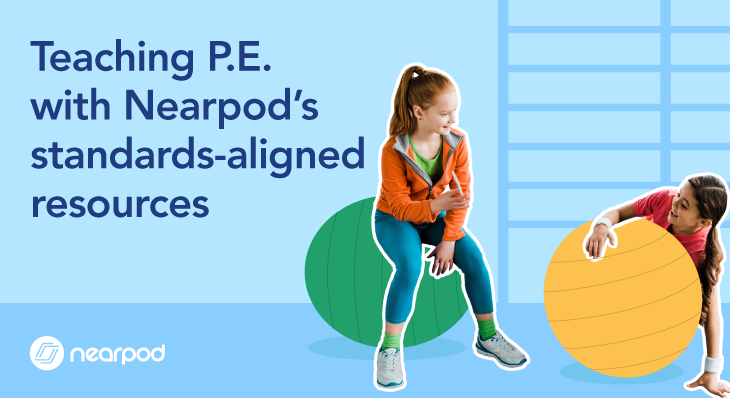
Teaching P.E. with Nearpod’s standards-aligned resources
With Nearpod’s powerful formative assessment tools and dynamic media, you can integrate technology when teaching physical education to boost student collaboration and engagement. Nearpod can help support differentiation and have students work together through standards-aligned P.E. lessons. Continue reading to learn more about how Nearpod can help you teach P.E. with standards top of mind.
We’d like to recognize our fantastic thought partners from the LAUSD P.E. Department for helping to inspire this post. Additionally, thank you to Dr. Daum, Associate Professor in the department of Kinesiology from Cal State San Jose, and Sydney Price, a Physical Education teacher at Argonaut Elementary School, for their contributions to this blog post.
Since physical education teachers do not typically have an adopted textbook and resources, it is important for teachers to unpack standards. Unpacking standards reveals underlying content as well as prerequisite knowledge. In doing so, teachers can also use the Technology, Pedagogy, and Content Knowledge framework (TPACK) in designing learning experiences.
The examples in this section use the SHAPE America National Standards for K-12 Physical Education and three domains of learning (psychomotor, cognitive, and affective) as a framework. Each domain of learning includes formative and summative assessment ideas using Nearpod to check for understanding throughout the lesson and unit to collect evidence of and for student learning.
The strategies listed below should be used to help teach for mastery. When teaching for mastery, physical educators need to take five steps. These include:
1. Creating a mastery environment
2. Designing deliberate practice tasks
3. Maximizing the number of practice opportunities
4. Integrating strategies and tactics into practice tasks
5. Providing specific feedback and assessment
Psychomotor (SHAPE America Standards 1 and 3)
Formative Assessments
- Video: Use to show proper motor skills, tactics and strategies. Embed questions directly into videos as formative assessments as students take a break from practicing the motor skills or movement patterns involved in a workout.
- Memory Test: Put exercises or fundamental movement patterns on the cards. When a student uncovers a matching pair, everyone performs the movement or exercise. For example, S1.E27.2a Jumps a self-turned rope consecutively forward and backward with a mature pattern. S1.E23.4 Volleys a ball with a two-hand overhead pattern, sending it upward, demonstrating 4 of the 5 critical elements of a mature pattern. S1.E24 Strikes an object with a short-handled implement while demonstrating a mature pattern. Note that the three movement patterns mentioned are different generalized movement patterns and the activity requires random practice to enhance the learning according to motor learning research.
- Nearpod 3D: When addressing standard S3.M3.7, Participates in a variety of strength and endurance-fitness activities, using the full body image under staff pics to teach the students the underlying content of the standard having to do with identifying different muscles used in strength training. Have the students perform an exercise or movement using these muscles.
- Slide: Use for asynchronous student work. The slide show can include individual slides for the following:
- Activity Name
- Directions
- Pics or Videos
- Reflection
- Collaborate Board: Teacher chooses a student to post a movement or exercise with time or reps into the board. Once the tile appears, all students

Summative Assessments
- Flipgrid: Students upload videos demonstrating proficiency in specific motor skills.
- Slide: Use for asynchronous student work. The slide show can include individual slides for the following:
- Activity Name
- Directions
- Pictures or Videos
- Reflection
Cognitive (SHAPE America Standards 2 & 3)
When teaching cognitive standards, there are many Nearpod tools that can be used to form the student learning (i.e., assessment for learning).
Tools for Formative Assessments:
- Matching Pairs
- Time to Climb
- Poll
- Collaborate Board
- Draw It
- Memory Test
Tools for Summative Assessments:
(more formal in nature and can be converted into a grade)
- Open-Ended Question
- Flipgrid
Affective (SHAPE America Standards 4 & 5)
Formative Assessments:
- Collaborative Board: Have students respond to questions such as “what does sportspersonship mean to you” or respond to a scenario such as “James is nervous or reluctant about participating on your team, what can you do or say to invite James to feel included?”
- Draw it: Do a “this or that” activity where students can engage with different scenarios to choose between options.
- Matching pairs: Set up pairs so students can match affective words or phrases such as “empathy” with the definition, image, or example of that term.

Summative Assessments:
- Open-ended Question: Ask questions, which can be based on a scenario, for students to provide analysis and solutions to content related to personal and social responsibility and the value of physical activity.
- Flipgrid: Students upload videos of themselves practicing pro-social behaviors, providing feedback to others, and being personally and socially responsible.
Lastly, in physical education, Nearpod can be used with principles of Universal Design for Learning and the essential guidelines of representation, engagement, and action/expression. For example, teachers can provide multiple means of engagement by fostering collaboration and community using Nearpod’s Collaboration Board. Reference: UDL: The UDL Guidelines (cast.org)
Nearpod offers multiple solutions for teachers of all subjects and grade levels, all within one platform. Through various formative assessment tools, engaging activities, and lesson sharing capabilities, Nearpod can help support you and your students in any classroom setting. Searching for more ways to implement Nearpod in your physical education classroom? Check out this blog post to explore more ideas.
References:
Stevie Chepko & Robert Doan (2015) Teaching for Skill Mastery, Journal of Physical Education, Recreation & Dance, 86:7, 9-13, DOI: 10.1080/07303084.2015.1064683
Kristi Roth (2014) Technology for Tomorrow’s Teachers, Journal of Physical Education, Recreation and Dance, 85:4, 3-5, DOI: 10.1080/07303084.2014.884420
Richard A. Schmidt, Craig A. Wrisberg (2008) Motor Learning & Performance, A Situation-Based Learning Approach, Human Kinetics, Champaign, IL.

Nearpod’s award-winning platform is used by thousands of schools around the globe, transforming classroom engagement.

